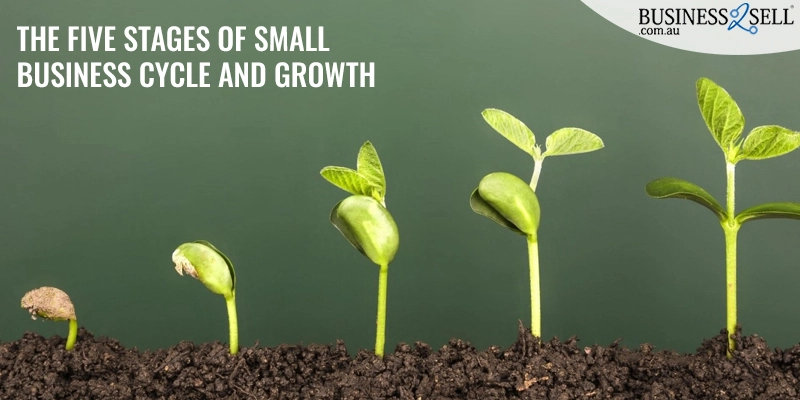Wednesday 24th of October 2018
The adage ‘Rome was not built in a day’ holds true for business development as it tak
...es time and patience to reach the top. Whether it...

The adage ‘Rome was not built in a day’ holds true for business development as it takes time and patience to reach the top. Whether it is a small entity or a large corporate, the basics of growth do not change. Every business is launched with the aim of expansion and growth. However, the target cannot be achieved overnight. The venture has to go through various stages of development to become a well-established company.
An entrepreneur has to face several challenges and roadblocks before tasting success. It is an uphill task that is completed in a step-by-step procedure and follows a standardised pattern across industries. If you are planning to purchase a business for sale in Australia, you must be aware of the stages of the business life cycle. It is your key to understanding the road to growth and development with all the milestones that need to be covered. So here are the five stages of the small business cycle explained for your reference.

The first stage of the business life cycle is the period after the launch when the entrepreneur is trying to establish the venture in the market. It is the period of creating brand awareness and attracting customers to start selling. However, the products or services are new to the market, and that is why the sales are low. Since the business owner has to build a brand from scratch, it takes a lot of effort, planning, and capital to acquire customers. The challenge is to carve a niche and develop a unique selling proposition that helps in building a competitive advantage. A start-up has a lot of other expenses that run high during the initial phase of establishment. Thus, the introduction stage is often marked by a monetary crisis and leads to failure.
It is essential to do thorough market research before entering the segment and understanding the needs and desires of customers. The business owner must cover the market gaps and position itself as a credible entity that can satisfy the needs of the customers. It helps in the initiation of sales, which reduce the risk of running out of capital and make moving on to the next stage much easier.
The second stage of staying afloat begins when the business grabs a small share of the market and capital starts pouring into the company. The key here is to maintain the sales through repeat orders and amplifying the numbers by attracting more customers. It is the stage where you must reach the breakeven point and develop strategies to start generating a return on investment.
It is a challenging stage as it decides the fate of the business if you are able to pull through the choppy waters. At this point, your target audience has become familiar with the brand, but you must be able to influence them to purchase. It is essential to generate the cash flow required to reach the next stage of business growth. The entrepreneur must devise short-term and long-term plans to sustain the company that include developing customer relationships and introducing loyalty programs. Aggressive marketing can further strengthen the value of the brand and helps in retaining existing customers and acquiring new ones.
Nothing succeeds like success, but it can be hard to get. It is the stage where the entrepreneur does not have to struggle to maintain the profits and they keep coming on their own. However, marketers should not feel complacent once they start generating profits. It is time to take control of the finances and use the profits for the improvement and development of the business. The most significant aspect of this stage is to identify how to maintain a steady flow of profits.
A wise way to keep growing is to invest the income back into the business for expansion. The entrepreneur should determine ways of accomplishing its long-term goals that may include improving capabilities through better equipment, new talent, the introduction of technology, etc. If the marketer intends to grow, it is necessary to enhance productivity and competence to match the needs of the expanding customer base. It is imperative to become ready for the future demands of the market and change in consumer behaviour when you enter new markets.
Companies that achieve success and continue to grow reach the growth stage where expansion takes centre stage. The number of customers keeps growing at this stage and the business must expand consistently by bringing new products and services in the market. It is the right time to get out of the small business segment and enter the league of the big corporates. The entrepreneur may also expand by acquiring small businesses in the domain and diversifying his offerings.
However, the fast growth of the entity should not lead to conflicts and scarcity of resources internally. Thus, the marketer must enhance the organisation from within and delegate responsibilities to a team of qualified and expert managers. The entire workforce should have their goals aligned with the vision of the company and must work in a cohesive and streamlined manner to follow the pace of the expansion. Thus, this stage needs constant progress on every front to move forward without any disruption.
The stage of expansion has a limited lifespan, and it reaches the stage of maturity. It is the period when growth starts declining, but the business is stable and continues to operate at its pace. It is the time when the marketer should focus on building the strengths of the business so that it does not get affected by setbacks. It is the phase where the entrepreneur can sit back and relax but also be ready to seize opportunities that help in growing the business. The best way to stay relevant and strong is to keep innovating and evolving to resonate with the target audience.

Many businesses fail after reaching the stage of maturity because they do not feel the urge to improvise at this stage. However, every business needs to change with the changing times to keep moving ahead. Otherwise, they can end up like Nokia, which ignored advancement in technology and lost the game after being on top for a while. Growth is an ongoing process, and it should not cease at any point in the business life cycle.
Conclusion
Every company goes through rough patches and successful streaks. The entrepreneur must be able to lead the venture through every phase with grit, determination, and acumen. Thus, if you are planning to purchase a business for sale in Australia, you must be aware of the five stages of the small business cycle to accomplish your goals through each step.

The capital of Victoria is touted as the second most populous city in Australia. It is undeniably a treasure trove of golden stretched beaches, scenic...

Owning an established business in Australia comes with the perks of a proven business model, immediate cash flow, strong goodwill, a loyal customer...